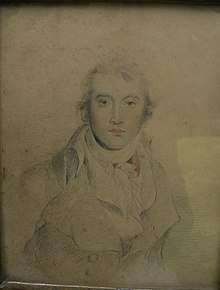Thomas Read Kemp
Thomas Read Kemp (23 December 1782 – 20 December 1844) was an English property developer and politician.

Life
He was the son of Sussex landowner and Member of Parliament Thomas Kemp, and his wife Anne, daughter of Henry Read of Brookland. He was educated at Westminster School, and matriculated at St John's College, Cambridge in 1801. He graduated B.A. 1805, M.A. 1810. He entered the Middle Temple in 1804.[1]
Kemp conceived and developed the Regency-style Kemp Town estate in Brighton on the south coast of England. He was Member of Parliament for Lewes 1811–16 and 1826–37 and for Arundel 1823–26.[2] He fled Britain in 1837 to escape his creditors and died in Paris in 1844. He is buried in Père Lachaise Cemetery. A tablet was erected to his memory at St Nicholas's Church next to his wife's.
Family

Kemp married Frances Baring, daughter of Sir Francis Baring, 1st Baronet and Harriet Herring in 1806. They had four sons and six daughters. She died during childbirth in 1825 and was buried at St. Nicholas's Church.
As second marriage in 1832, Kemp wedded Frances Shakerley of Somerford, widow of Harvey Vigors. They had one son.[2]
References
- Rose Collis (2010) The New Encyclopedia of Brighton Brighton and Hove City Council
Notes
- "Kemp, Thomas Read (KM800TR)". A Cambridge Alumni Database. University of Cambridge.
- "Kemp, Thomas Read (1782–1844), of Hurstmonceaux Park, Suss., History of Parliament Online". Retrieved 19 June 2015.
External links
- Hansard 1803–2005: contributions in Parliament by Thomas Read Kemp
- Thomas Read Kemp
| Parliament of the United Kingdom | ||
|---|---|---|
| Preceded by Henry Shelley Thomas Kemp |
Member of Parliament for Lewes 1811–1816 With: Henry Shelley 1811–1812 George Shiffner 1812–1816 |
Succeeded by George Shiffner Sir John Shelley, Bt |
| Preceded by Viscount Bury Robert Blake |
Member of Parliament for Arundel 1823–1826 With: Viscount Bury |
Succeeded by Edward Lombe John Atkins |
| Preceded by Sir John Shelley, Bt George Shiffner |
Member of Parliament for Lewes 1826–1837 With: Sir John Shelley, Bt 1826–1831 Sir Charles Blunt, Bt 1831–1837 |
Succeeded by Sir Charles Blunt, Bt Henry FitzRoy |